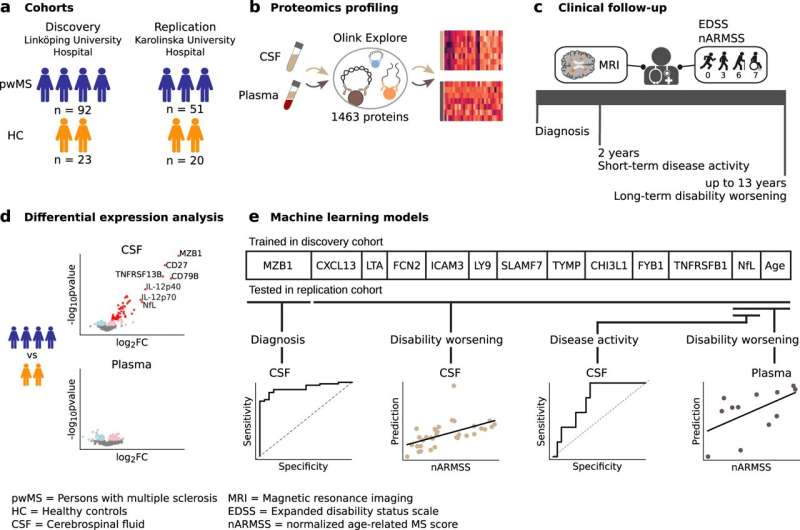This article has been reviewed according to Science X's editorial process and policies. Editors have highlighted the following attributes while ensuring the content's credibility:
fact-checked
peer-reviewed publication
trusted source
proofread
Severe multiple sclerosis predicted using machine learning

A combination of only 11 proteins can predict long-term disability outcomes in multiple sclerosis (MS) for different individuals. The identified proteins could be used to tailor treatments to the individual based on the expected severity of the disease. The study, "Proteomics reveal biomarkers for diagnosis, disease activity and long-term disability outcomes in multiple sclerosis," led by researchers at Linköping University in Sweden, has been published in the journal Nature Communications.
"A combination of 11 proteins predicted both short and long-term disease activity and disability outcomes. We also concluded that it's important to measure these proteins in cerebrospinal fluid, which better reflects what's going on in the central nervous system, compared with measuring in the blood," says Julia Åkesson, doctoral student at Linköping University and the University of Skövde.
In multiple sclerosis, the immune system attacks the person's own body, damaging nerves in the brain and in the spinal cord. What is attacked primarily is a fatty compound called myelin, which surrounds and insulates the nerve axons so that signals can be transmitted. When myelin is damaged, transmission becomes less efficient.
Disease progression in multiple sclerosis varies considerably from person to person. To those for whom a more severe disease is predicted, it is important not to lose valuable time at the onset of the disease but to get the right treatment quickly.
The researchers behind the current study, which is a collaboration between Linköping University, the Karolinska Institute and the University of Skövde, wanted to find out whether it was possible to detect at an early stage of disease which patients would require a more powerful treatment. Being able to do so would be relevant both to physicians and those living with MS.
"I think we've come one step closer to an analysis tool for selecting which patients would need more effective treatment in an early stage of the disease. But such a treatment may have side effects and be relatively expensive, and some patients don't need it," says Mika Gustafsson, professor of bioinformatics at the Department of Physics, Chemistry and Biology at Linköping University, who led the study.

From 1,500 to 11 proteins
Finding markers linked to disease severity many years ahead is a complicated challenge. In their study, the researchers analyzed nearly 1,500 proteins in samples from 92 people with suspected or recently diagnosed MS. Data from the protein analyses were combined with a large amount of information from the patients' journals, such as disability, results from MRI scans of the nervous system, and treatments received. Using machine learning, the researchers found a number of proteins that could predict disease progression.
"Having a panel consisting of only 11 proteins makes it easy should anyone want to develop analysis for this. It won't be as costly as measuring 1,500 proteins, so we've really narrowed it down to make it useful for others wanting to take this further," says Sara Hojjati, doctoral student at the Department of Biomedical and Clinical Sciences at Linköping University.
The research team also found that a specific protein, leaking from damaged nerve axons, is a reliable biomarker for disease activity in the short term. This protein is called neurofilament light chain, NfL. These findings confirm earlier research on the use of NfL to identify nerve damage and also suggest that the protein indicates how active the disease is.
One of the main strengths of the study is that the combination of proteins found in the patient group from which samples were taken at Linköping University Hospital was later confirmed in a separate group consisting of 51 MS patients sampled at the Karolinska University Hospital in Stockholm.
This study is the first to measure such a large amount of proteins with a highly sensitive method, proximity extension assay, combined with next-generation sequencing, PEA-NGS. This technology allows for high-accuracy measuring also of very small amounts, which is important as these proteins are often present in very low levels.
More information: Julia Åkesson et al, Proteomics reveal biomarkers for diagnosis, disease activity and long-term disability outcomes in multiple sclerosis, Nature Communications (2023). DOI: 10.1038/s41467-023-42682-9



















